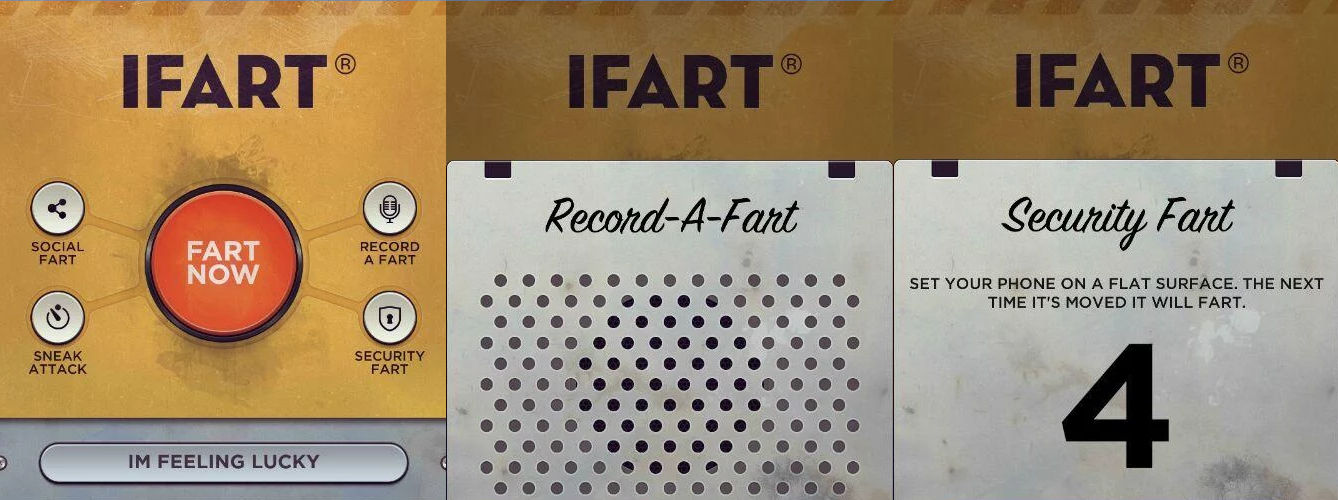Back in 2008, there was an app that started a craze and produced a putrid cloud of copycats: iFart.
That early start helped the infamous fart app gain the attention of the masses and, today, iFart is available on Android for the first time.
Just how big a noise did the original app make?
It was so popular, it held the top overall spot on the Apple App Store at the time. Not just above other paid apps: It floated above all other apps. iFart made appearances on The Daily Show with Jon Stewart, and with TODAY’s Kathie Lee & Hoda. George Clooney even endorsed iFart in an article published by Rolling Stone, and video game industry legend Peter Molyneux chose it as his favorite fart app in an interview with Game Informer.
And it made its developer — InfoMedia, headed up by Joel Comm — a warm and satisfying $40,000 across Christmas Eve and Christmas Day in 2008.
“Remember that the first app came out in the early days,” Comm told me. “The user base was much lower. But we sold about 800,000 units straight up in 2008-2010.”
That’s an impressive feat, but iFart on Android is coming to a very different app world.
“When iFart first launched there were only a few players in the ‘fart niche’,” Comm said. “And honestly, the app store was still very new.”
He’s right. Across Apple’s App Store and Google Play, there are now over 1,200 fart apps. Don’t expect to be able to drop a stealth bomb using the Apple Watch anytime soon, though — Apple has banned them.
So just how did Comm get the original app noticed on mainstream TV, and what effect did that have?
“There were a lot of factors that caused iFart to go viral and get noticed,” Comm said. “We ran a marketing company, and had large twitter followings and mailing lists to help us seed initial installs. We also had connections with bloggers who were looking for stories about the App store. The number one question they had was ‘how much are you making?’. So when we started publishing that data a number of tech blogs picked up the story.”
All standard marketing so far, right? But the iFart story took an unusual turn when a competitor created a stink over the phrase “pull my finger.”
“We got sued by a competing fart app, which quite frankly was a golden opportunity to get media coverage,” Comm said. That court case led to an appearance on The Daily Show, which in turn caused a ripple effect. “We started seeing tweets from celebrities who were using iFart, and the app became the defacto ‘stupid app’: Any writer who wanted to write about the top
apps, or dumb apps, or ridiculous money that could be made would mention iFart. At one point it seemed like a requirement to reference iFart in any story about the App store.”
While getting sued isn’t a great app store optimization technique, it sure helped iFart gain its slice of the cheese.
Now that thousands of competitors exist, what has changed in the new iFart app? And how will InfoMedia repeat the success of the first?
“The original app had a few signature features, and we’ve stuck with that original concept for the Android version,” Comm said. “So the Android version of iFart is essentially the same app as our original release on iTunes, just re-coded and optimized.”
That includes the fart timer, the motion-detected fart, the ability to record your own, and social sharing capabilities. But that’s not the whole story. While the original was $0.99, InfoMedia is letting this one go free.
“We have added a number of additional fart packs in both iOS and Android versions,” Comm said. “These fart packs include parodies of musical hits and the Star Wars universe. The Android version is free to download, and there are no ads. The app is currently solely monetized with in-app purchases.”
For Comm, the success of the original is a bonus, but he’s not resting on his laurel-motif whoopee cushion.
“To move up the charts initially, we’ll be launching Facebook campaigns and Google AdWords Campaigns,” Comm said. “We’ll push out some images and videos via social media channels too.”
So what is most important when trying to get your app noticed, according to Comm? And what factors can move the needle in big ways?
“First and foremost, you need to have a quality app,” Comm said. “If features and functions don’t work, negative reviews can derail installs fast. Make sure your app is heavily beta tested and works as promised. Next, the description of the app is very important. Google has a number of guidelines and best practices. Just like with web page SEO, you need to think about what your potential customers will be searching for. Use the right keywords in your title and description. And just like SEO for websites, you should be looking at your competitors’ descriptions to gain insight as to what makes an app rank.”
We’re turd-ally on board with these app store optimization (ASO) tactics. In fact, we’ll be holding up a match to bring light to the world of ASO in the near future with a forthcoming ASO report on VB Insight.
iFart is downloadable from today on Android via Google Play and is currently available on the Apple App Store. Tha app is free with in-app purchases. No joke.
VentureBeat's mission is to be a digital town square for technical decision-makers to gain knowledge about transformative enterprise technology and transact. Learn More


